Zhijing Jin
The Reasoning-Memorization Interplay in Language Models Is Mediated by a Single Direction
Mar 29, 2025Abstract:Large language models (LLMs) excel on a variety of reasoning benchmarks, but previous studies suggest they sometimes struggle to generalize to unseen questions, potentially due to over-reliance on memorized training examples. However, the precise conditions under which LLMs switch between reasoning and memorization during text generation remain unclear. In this work, we provide a mechanistic understanding of LLMs' reasoning-memorization dynamics by identifying a set of linear features in the model's residual stream that govern the balance between genuine reasoning and memory recall. These features not only distinguish reasoning tasks from memory-intensive ones but can also be manipulated to causally influence model performance on reasoning tasks. Additionally, we show that intervening in these reasoning features helps the model more accurately activate the most relevant problem-solving capabilities during answer generation. Our findings offer new insights into the underlying mechanisms of reasoning and memory in LLMs and pave the way for the development of more robust and interpretable generative AI systems.
DARS: Dynamic Action Re-Sampling to Enhance Coding Agent Performance by Adaptive Tree Traversal
Mar 18, 2025Abstract:Large Language Models (LLMs) have revolutionized various domains, including natural language processing, data analysis, and software development, by enabling automation. In software engineering, LLM-powered coding agents have garnered significant attention due to their potential to automate complex development tasks, assist in debugging, and enhance productivity. However, existing approaches often struggle with sub-optimal decision-making, requiring either extensive manual intervention or inefficient compute scaling strategies. To improve coding agent performance, we present Dynamic Action Re-Sampling (DARS), a novel inference time compute scaling approach for coding agents, that is faster and more effective at recovering from sub-optimal decisions compared to baselines. While traditional agents either follow linear trajectories or rely on random sampling for scaling compute, our approach DARS works by branching out a trajectory at certain key decision points by taking an alternative action given the history of the trajectory and execution feedback of the previous attempt from that point. We evaluate our approach on SWE-Bench Lite benchmark, demonstrating that this scaling strategy achieves a pass@k score of 55% with Claude 3.5 Sonnet V2. Our framework achieves a pass@1 rate of 47%, outperforming state-of-the-art (SOTA) open-source frameworks.
Revealing Hidden Mechanisms of Cross-Country Content Moderation with Natural Language Processing
Mar 07, 2025Abstract:The ability of Natural Language Processing (NLP) methods to categorize text into multiple classes has motivated their use in online content moderation tasks, such as hate speech and fake news detection. However, there is limited understanding of how or why these methods make such decisions, or why certain content is moderated in the first place. To investigate the hidden mechanisms behind content moderation, we explore multiple directions: 1) training classifiers to reverse-engineer content moderation decisions across countries; 2) explaining content moderation decisions by analyzing Shapley values and LLM-guided explanations. Our primary focus is on content moderation decisions made across countries, using pre-existing corpora sampled from the Twitter Stream Grab. Our experiments reveal interesting patterns in censored posts, both across countries and over time. Through human evaluations of LLM-generated explanations across three LLMs, we assess the effectiveness of using LLMs in content moderation. Finally, we discuss potential future directions, as well as the limitations and ethical considerations of this work. Our code and data are available at https://github.com/causalNLP/censorship
Causality Is Key to Understand and Balance Multiple Goals in Trustworthy ML and Foundation Models
Feb 28, 2025Abstract:Ensuring trustworthiness in machine learning (ML) systems is crucial as they become increasingly embedded in high-stakes domains. This paper advocates for the integration of causal methods into machine learning to navigate the trade-offs among key principles of trustworthy ML, including fairness, privacy, robustness, accuracy, and explainability. While these objectives should ideally be satisfied simultaneously, they are often addressed in isolation, leading to conflicts and suboptimal solutions. Drawing on existing applications of causality in ML that successfully align goals such as fairness and accuracy or privacy and robustness, this paper argues that a causal approach is essential for balancing multiple competing objectives in both trustworthy ML and foundation models. Beyond highlighting these trade-offs, we examine how causality can be practically integrated into ML and foundation models, offering solutions to enhance their reliability and interpretability. Finally, we discuss the challenges, limitations, and opportunities in adopting causal frameworks, paving the way for more accountable and ethically sound AI systems.
Causality can systematically address the monsters under the bench(marks)
Feb 07, 2025Abstract:Effective and reliable evaluation is essential for advancing empirical machine learning. However, the increasing accessibility of generalist models and the progress towards ever more complex, high-level tasks make systematic evaluation more challenging. Benchmarks are plagued by various biases, artifacts, or leakage, while models may behave unreliably due to poorly explored failure modes. Haphazard treatments and inconsistent formulations of such "monsters" can contribute to a duplication of efforts, a lack of trust in results, and unsupported inferences. In this position paper, we argue causality offers an ideal framework to systematically address these challenges. By making causal assumptions in an approach explicit, we can faithfully model phenomena, formulate testable hypotheses with explanatory power, and leverage principled tools for analysis. To make causal model design more accessible, we identify several useful Common Abstract Topologies (CATs) in causal graphs which help gain insight into the reasoning abilities in large language models. Through a series of case studies, we demonstrate how the precise yet pragmatic language of causality clarifies the strengths and limitations of a method and inspires new approaches for systematic progress.
Towards Global AI Inclusivity: A Large-Scale Multilingual Terminology Dataset
Dec 24, 2024Abstract:The field of machine translation has achieved significant advancements, yet domain-specific terminology translation, particularly in AI, remains challenging. We introduced GIST, a large-scale multilingual AI terminology dataset containing 5K terms extracted from top AI conference papers spanning 2000 to 2023. The terms were translated into Arabic, Chinese, French, Japanese, and Russian using a hybrid framework that combines LLMs for extraction with human expertise for translation. The dataset's quality was benchmarked against existing resources, demonstrating superior translation accuracy through crowdsourced evaluation. GIST was integrated into translation workflows using post-translation refinement methods that required no retraining, where LLM prompting consistently improved BLEU and COMET scores. A web demonstration on the ACL Anthology platform highlights its practical application, showcasing improved accessibility for non-English speakers. This work aims to address critical gaps in AI terminology resources and fosters global inclusivity and collaboration in AI research.
Causal Responsibility Attribution for Human-AI Collaboration
Nov 05, 2024Abstract:As Artificial Intelligence (AI) systems increasingly influence decision-making across various fields, the need to attribute responsibility for undesirable outcomes has become essential, though complicated by the complex interplay between humans and AI. Existing attribution methods based on actual causality and Shapley values tend to disproportionately blame agents who contribute more to an outcome and rely on real-world measures of blameworthiness that may misalign with responsible AI standards. This paper presents a causal framework using Structural Causal Models (SCMs) to systematically attribute responsibility in human-AI systems, measuring overall blameworthiness while employing counterfactual reasoning to account for agents' expected epistemic levels. Two case studies illustrate the framework's adaptability in diverse human-AI collaboration scenarios.
Multilingual Trolley Problems for Language Models
Jul 02, 2024


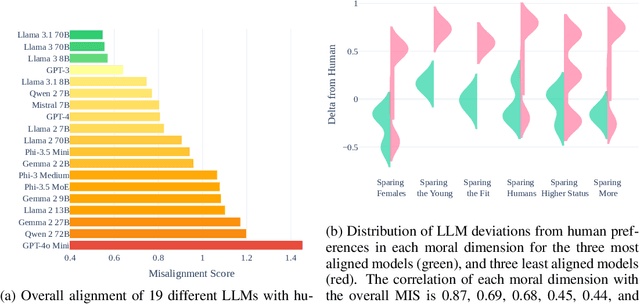
Abstract:As large language models (LLMs) are deployed in more and more real-world situations, it is crucial to understand their decision-making when faced with moral dilemmas. Inspired by a large-scale cross-cultural study of human moral preferences, "The Moral Machine Experiment", we set up the same set of moral choices for LLMs. We translate 1K vignettes of moral dilemmas, parametrically varied across key axes, into 100+ languages, and reveal the preferences of LLMs in each of these languages. We then compare the responses of LLMs to that of human speakers of those languages, harnessing a dataset of 40 million human moral judgments. We discover that LLMs are more aligned with human preferences in languages such as English, Korean, Hungarian, and Chinese, but less aligned in languages such as Hindi and Somali (in Africa). Moreover, we characterize the explanations LLMs give for their moral choices and find that fairness is the most dominant supporting reason behind GPT-4's decisions and utilitarianism by GPT-3. We also discover "language inequality" (which we define as the model's different development levels in different languages) in a series of meta-properties of moral decision making.
The Odyssey of Commonsense Causality: From Foundational Benchmarks to Cutting-Edge Reasoning
Jun 27, 2024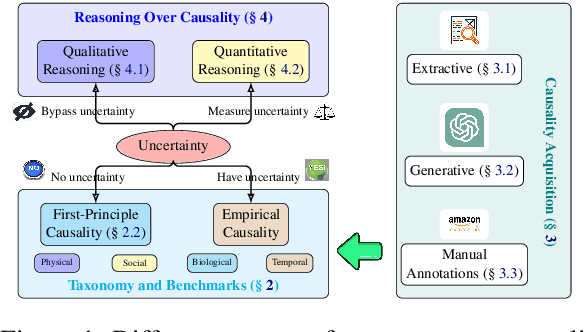
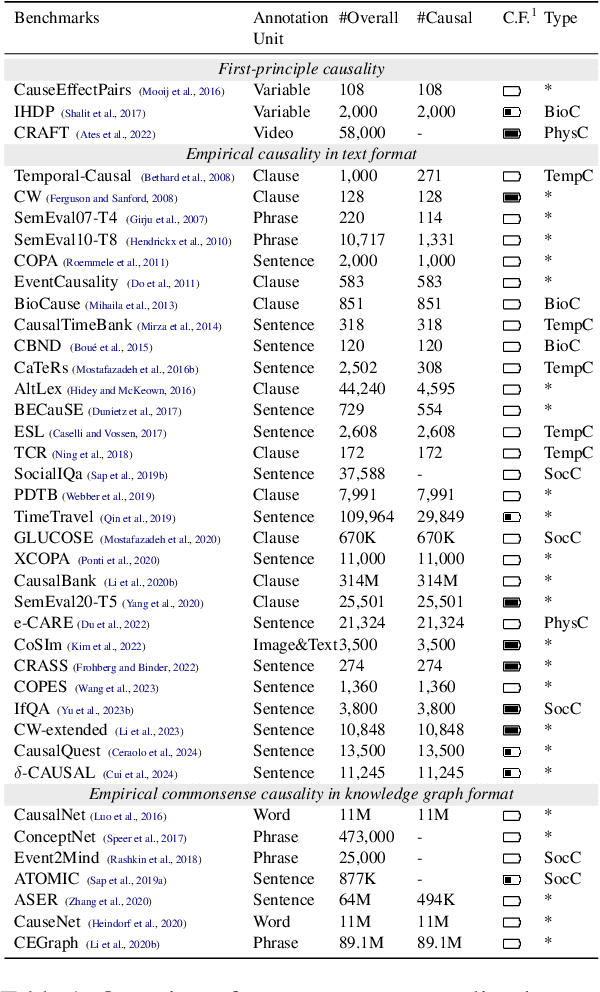
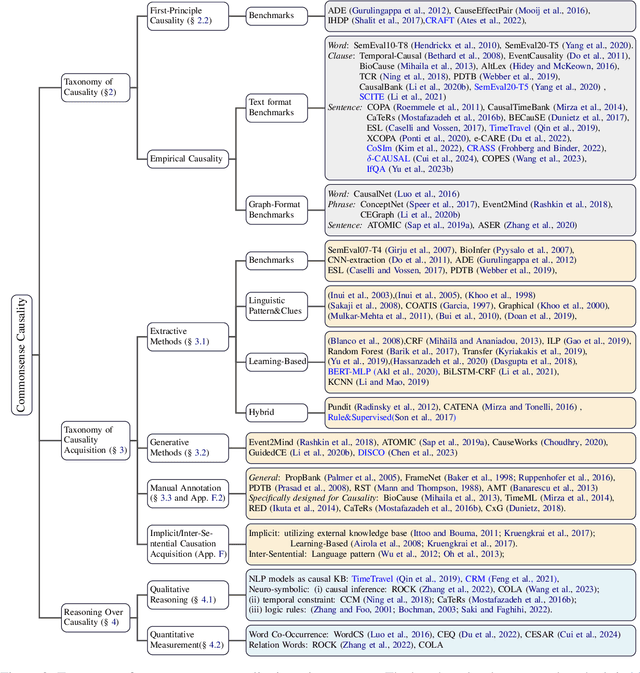
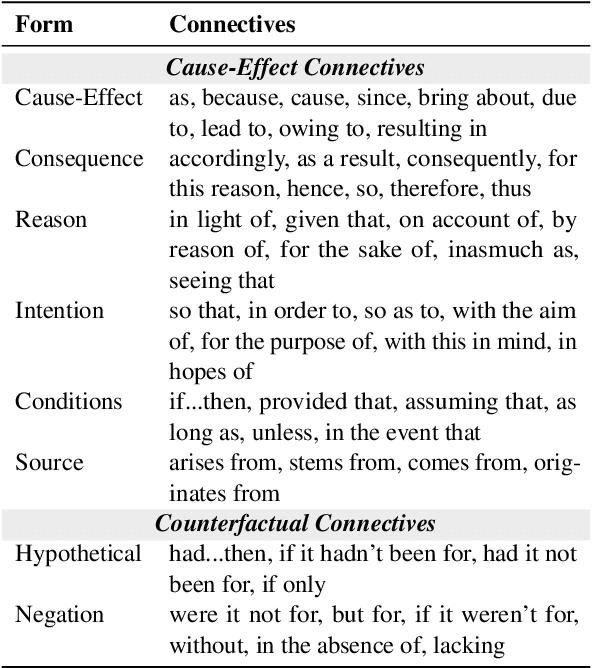
Abstract:Understanding commonsense causality is a unique mark of intelligence for humans. It helps people understand the principles of the real world better and benefits the decision-making process related to causation. For instance, commonsense causality is crucial in judging whether a defendant's action causes the plaintiff's loss in determining legal liability. Despite its significance, a systematic exploration of this topic is notably lacking. Our comprehensive survey bridges this gap by focusing on taxonomies, benchmarks, acquisition methods, qualitative reasoning, and quantitative measurements in commonsense causality, synthesizing insights from over 200 representative articles. Our work aims to provide a systematic overview, update scholars on recent advancements, provide a pragmatic guide for beginners, and highlight promising future research directions in this vital field.
On Affine Homotopy between Language Encoders
Jun 04, 2024



Abstract:Pre-trained language encoders -- functions that represent text as vectors -- are an integral component of many NLP tasks. We tackle a natural question in language encoder analysis: What does it mean for two encoders to be similar? We contend that a faithful measure of similarity needs to be \emph{intrinsic}, that is, task-independent, yet still be informative of \emph{extrinsic} similarity -- the performance on downstream tasks. It is common to consider two encoders similar if they are \emph{homotopic}, i.e., if they can be aligned through some transformation. In this spirit, we study the properties of \emph{affine} alignment of language encoders and its implications on extrinsic similarity. We find that while affine alignment is fundamentally an asymmetric notion of similarity, it is still informative of extrinsic similarity. We confirm this on datasets of natural language representations. Beyond providing useful bounds on extrinsic similarity, affine intrinsic similarity also allows us to begin uncovering the structure of the space of pre-trained encoders by defining an order over them.
 Add to Chrome
Add to Chrome Add to Firefox
Add to Firefox Add to Edge
Add to Edge